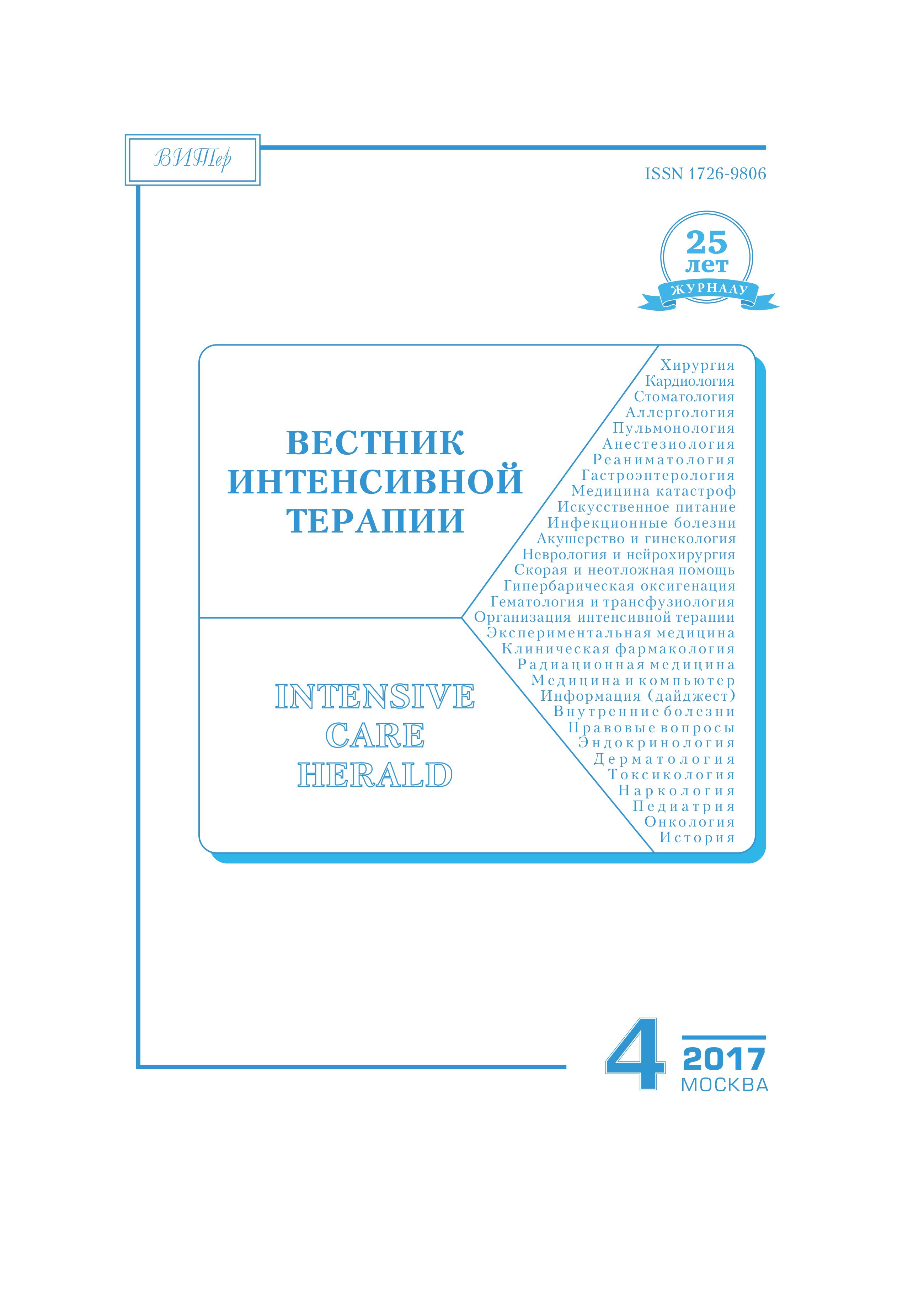Abstract
The review presents modern approaches to managing patients with chronic kidney disease at various stages of the perioperative period. Among patients requiring surgical intervention, the proportion of patients with initially impaired renal function is increasing, many of them are on programmed dialysis. Reduction of kidney function is observed in 36 % of persons over the age of 60 and in 16 % of patients of working age. The main goal of perioperative management of the patient with concomitant renal pathology is the prevention of the development of acute renal damage on a background of chronic. Such patients require more careful monitoring at all stages of treatment, a special infusion therapy approach, continuity during renal replacement therapy, correction of analgesics, anesthetics, antimicrobials and anticoagulants doses. Non-compliance with these principles is inevitably associated with an increase in the frequency of perioperative complications and mortality.References
- Периоперационное ведение больных с сопутствующими заболеваниями: под ред. И.Б. Заболотских. Т. 2-е изд., перераб. и доп. М.: Практическая медицина, 2016. [Perioperative management of patients with co-existing diseases: ed. I.B. Zab- olotskikh. Vol. 1. 2nd ed., rev. and enlarg. Moscow: Prakticheska- ja meditsina, 2016. (In Russ)]
- Периоперационное ведение больных с сопутствующими заболеваниями: под ред. И.Б. Заболотских. Т. 2-е изд., пере- раб. и доп. М.: Практическая медицина, 2016. [Perioperative management of patients with co-existing diseases: ed. I.B. Zab- olotskikh. Vol. 2. 2nd ed., rev. and enlarg. Moscow: Prakticheskaja meditsina, 2016. (In Russ)]
- Анестезиология-реаниматология: клинические рекомендации: под ред. И.Б. Заболотских и Е.М. Шифмана. М.: ГЭОТАР-Медиа, [Anesthesiology and Reanimatology: сlinical guidelines. Eds. I.B. Zabolotskikh and E.M. Shifman. Moscow: GEOTAR-Media, 2016. (In Russ)]
- Добронравов В.А., Смирнов А.В., Драгунов С.В. и др. Эпидемиология хронической болезни почек. Нефрология. 2004; 8(1): 36–41. [Dobronravov V.A., Smirnov A.V., Dragunov S.V. et al. Epidemiology of chronic kidney Nefrologija. 2004; 8(1): 36–41. (In Russ)]
- Vaaraa S.T., Bellomo R. Postoperative renal dysfunction after noncardiac surgery. Opin. Crit. Care. 2017; 23(5): 440– 446. doi: 10.1097/MCC.0000000000000439.
- Fuhrman D.Y., Kellum J.A. Epidemiology and pathophysiology of cardiac surgery-associated acute kidney Curr. Opin. Anes- thesiol. 2017; 30: 60–65. doi: 10.1097/ACO.0000000000000412.
- Hobson C., Ruchi R., Bihorac A. Perioperative Acute Kidney Injury. Risk Factors and Predictive Strategies. Crit. Care. Clin. 2017; 33: 379–396. doi: 1016/j.ccc.2016.12.008.
- Palanta C.E., Amdurb R.L., Chawla L.S. Long-term consequences of acute kidney injury in the perioperative Curr. Opin. Anes- thesiol. 2017; 30: 100–104. doi: 10.1097/ACO.0000000000000428.
- Eilers H., Liu К.D., Gruber А., Niemann U. Chronic kidney disease: implications for the perioperative period. Minerva Anestesiol. 2010; 76: 725–736.
- Levey A.S., de Jong P.E., Coresh J. et al. The definition, classification and prognosis of chronic kidney disease: a KDIGO Con- troversies Conference report. Kidney Int. 2011; 80(1): 17–28. doi: 1038/ki.2010.483.
- Смирнов А.В., Шилов E.М., Добронравов В.А., Каюков И.Г., Бобкова И.Н. и др. Национальные рекомендации. Хроническая болезнь почек: основные принципы скрининга, диагностики, профилактики и подходы к лечению. СПб.: Левша, [Smirnov A.V., Shilov E.M., Dobronravov V.A., Kajukov I.G., Bobkova I.N. et al. National guidelines. Chronic kidney disease: basic principles of screening, diagnosis, prevention and treatment approaches. St.-Petersburg: Levsha, 2012. (In Russ)]
- Meersch M., Schmidt C., Zarbock A. Patient with chronic renal failure undergoing surgery. Current opinion in anaesthesiology. 2016; 29(3): 413–420. doi: 1097/ACO.0000000000000329.
- Porter C.J., Moppett I.K., Juurlink I., Nightingale J., Moran C.G., Devonald M.A. Acute and chronic kidney disease in elderly patients with hip fracture: prevalence, risk factors and outcome with develop- ment and validation of a risk prediction model for acute kidney BMC Nephrol. 2017; 18(1): 20. doi: 10.1186/s12882-017-0437-5.
- McClellan W.M., Flanders W.D. Risk factors for progressive chronic kidney disease. J. Am. Soc. 2003; 14: S65–S70.
- Fukushima S., Fujita T., Kobayashi J. Chronic Kidney Disease; Tips and Pitfall of Perioperative Management. Kyobu Geka. 2017; 70(8): 585–589.
- Kim Y., Shi J., Freeman C.M., Jung A.D., Dhar V.K. et al. Addressing the challenges of sleeve gastrectomy in end-stage renal disease: Analysis of 100 consecutive renal failure patients. Sur 2017; 162(2): 358–365. doi: 10.1016/j.surg.2017.02.011.
- Liang N.L., Yuo T.H., Al-Khoury G.E., Hager E.S., Ma- karoun M.S., Singh M.J. High mortality rates after both open surgical and endovascular thoracic aortic interventions in patients with end-stage renal disease. J. Surg. 2017; 66(4): 991–996. doi: 10.1016/j.jvs.2016.12.144.
- Locatelli F., Covic A., Eckardt K.U. et al. Anaemia management in patients with chronic kidney disease: a position statement by the Anaemia Working Group of European Renal Best Practice (ERBP). Nephrol. Dial. Transplant. 2009; 24: 348–354. doi: 1093/ndt/gfn653.
- Ravera M., Re M., Deferrari L., Vettoretti S., Deferrari G. Importance of blood pressure control in chronic kidney disease. J. Am. Soc. Nephrol. 2006; 17: S98–103.
- Kidney Disease Outcome Quality K/DOQI clinical practice guidelines on hypertension and antihypertensive agents in chronic kidney disease. Am. J. Kidney Dis. 2004; 43: S1–S290.
- Wagener G., Brentjens T.E. Anesthetic concerns in patients presenting with renal failure. Anesthesiol. Clin. 2010; 28(1): 39–54. doi: 1016/j.anclin.2010.01.006.
- Tsubokawa T. Pharmacokinetics of anesthesia related drugs in patients with chronic kidney disease. Masui. 2013; 62(11): 1293–1303.
- Brentjens T.E., Chadha R. Anesthesia for the Patient with Concomitant Hepatic and Renal Impairment. Anesthesiol. Clin. 2016; 34(4): 645–658. doi: 1016/j.anclin.2016.06.002.
- Safa R., Sadovnikoff N. Anesthesia for Patients with Concomitant Cardiac and Renal Dysfunction. Anesthesiol. Clin. 2016; 34(4): 697–710. doi: 1016/j.anclin.2016.06.006.
- Karambelkar A., Kasekar R., Palevsky P.M. Perioperative Pharmacologic Management of Patients with End Stage Renal Disease. Dial. 2015; 28(4): 392–396. doi: 10.1111/sdi.12384.
- Страчунский Л.С. Правила дозирования антибиотиков у пациентов с нарушением функции почек. Клиническая микробиология и антимикробная химиотерапия. 2000; 2: 86–92. [Strachunskij L.S. Rules for dosing antibiotics in patients with impaired renal function. Klinicheskaja mikrobiologija i antimikrobnaja himioterapija. 2000; 2: 86–92. (In Russ)]
- Bazinet A., Almanric K., Brunet C. et al. Dosage of enoxaparin among obese and renal impairment patients. Thromb. Res. 2005; 116: 41–50.
- Shprecher A.R., Cheng-Lai A., Madsen E.M. et al. Peak antifactor Xa activity produced by dalteparin treatment in patients with renal impairment compared with controls. Pharmacotherapy. 2005; 25: 817–822.

This work is licensed under a Creative Commons Attribution-NonCommercial-ShareAlike 4.0 International License.
Copyright (c) 2017 ANNALS OF CRITICAL CARE

